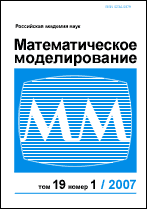|
This article is cited in 10 scientific papers (total in 10 papers)
On interpretation of the direct current electrical prospecting measurements
M. Yu. Zaslavskiiab
a Moscow State University
b Keldysh Institute for Applied Mathematics, RAS, Moscow
Abstract:
In the current paper the algorithm of interpretation of the electrical prospecting data is constructed. The interpretation is based on the solution of the inverse problem for the scalar elliptic equation. As a result of the problem solution, the distribution of electrical conductivity in the medium is obtained under known measured direct current between two electrodes, one of them is in the borehole and another one is far away from the first one. The admissible class of functions, the solution belongs to, is the intersection of $L^\infty$ and the space of functions with bounded variation. Although in the considered piece-wise constant models all heterogeneuities are large-scale, the fine enough grids are necessary for setting up the models in order to trace the apriori unknown interfaces. Hence the dimension of the vector of the unknown electrical conductivity in the inverse problem may be several tens of thousands while the number of measurements are $10^3$. It means that residual minimization leads to ill-conditioned problem. In the current paper the inverse problem is formulated in terms of minimization of the multiplicative smoothing functional with regularizator similar to the norm in the space of the bounded variation functions. The results of the interpretation of the measured data, presented at the end of the paper, for two- and three-dimensional problems show the effectiveness of the constructed algorithm. The considered examples are related to quasi-realistic data.
Received: 22.12.2008
Citation:
M. Yu. Zaslavskii, “On interpretation of the direct current electrical prospecting measurements”, Matem. Mod., 22:3 (2010), 3–14; Math. Models Comput. Simul., 3:1 (2011), 9–17
Linking options:
https://www.mathnet.ru/eng/mm2945 https://www.mathnet.ru/eng/mm/v22/i3/p3
|

| Statistics & downloads: |
| Abstract page: | 769 | | Full-text PDF : | 265 | | References: | 119 | | First page: | 15 |
|




 Contact us:
Contact us: Terms of Use
Terms of Use
 Registration to the website
Registration to the website Logotypes
Logotypes







 Citation in format
Citation in format 
